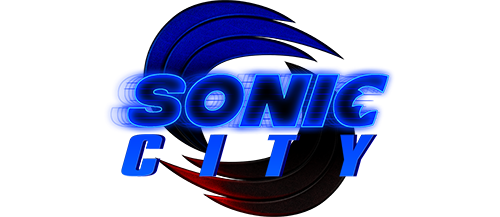in: Games, Main Series
Sonic Chaos
Sonic Chaos (ソニック&テイルス Sonikku & Teirusu, lit. “Sonic & Tails”) is a platforming video game within the Sonic the Hedgehog series. It was initially released exclusively for the Sega Master System in Europe and later for the Sega Game Gear worldwide in 1993. The game was developed by Aspect and published by Sega, and it served as the final platform-based Sonic title for the Master System in Europe.
The storyline of Sonic Chaos revolves around Dr. Eggman’s desire to harness the boundless power of the Chaos Emeralds. To achieve this, he seizes one of the Emeralds, causing the remaining five to be transported to an alternate dimension. This action triggers a chain of events that leads to South Island losing its buoyancy and sinking into the ocean. Sonic and Tails join forces to retrieve the scattered Emeralds and restore them to their rightful place before it’s too late.
Sonic Chaos shares numerous gameplay features with Sonic the Hedgehog 2 (8-bit) while introducing fresh move sets for the playable characters, new power-ups, and distinct mechanics. An important highlight of the game is its introduction of Tails as a playable character in an 8-bit Sonic title for the first time.
Plot
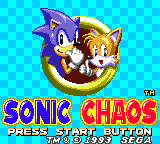
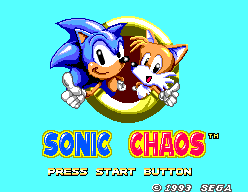
South Island is a serene and tranquil land, housing the six mystical Chaos Emeralds renowned for their boundless and life-giving power. Despite their potential to bestow life, these emeralds possess a darker side, capable of transforming into devastating weapons like nuclear bombs and laser devices.[1]Sonic Chaos (Sega Game Gear United States instruction booklet, pg. 4. This dual nature of the emeralds has attracted the attention of the malevolent scientific genius, Dr. Eggman.[2]Sonic & Tails (Sega Game Gear) Japanese instruction booklet, pgs. 4-5.
In the midst of their explorations, Sonic the Hedgehog and his loyal companion, Miles “Tails” Prower, catch wind of a troubling rumor indicating that Eggman has managed to seize one of the coveted Chaos Emeralds. Hurrying back to South Island, they are met with a distressing sight: the once peaceful haven has been thrown into chaos. It appears that Eggman’s act of taking a single Emerald has triggered a catastrophic event, causing the remaining emeralds to scatter and the very foundation of the island to crumble. The lifeline that held the island together was severed.
Though Eggman revels in his perceived victory, Sonic remains resolute. He is determined to reclaim the scattered Chaos Emeralds and rescue South Island from its impending demise. With his steadfast companion Tails at his side, Sonic embarks on a new and perilous adventure, vowing to restore harmony to the land and thwart Eggman’s sinister ambitions once and for all.
Characters
| Image | Character | Biography |
|---|---|---|
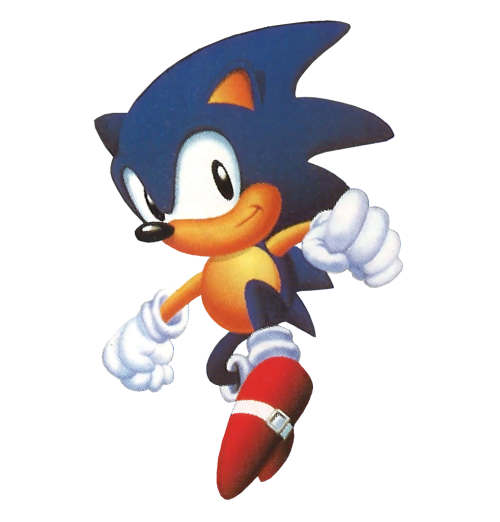 | Sonic the Hedgehog | After all’s said and done, Sonic is awesome and cool! That’s why the people who play him have to be high class. Sonic is the only one who can collect all the Chaos Emeralds.[3]Sonic & Tails (Sega Game Gear) Japanese instruction booklet, pg. 11. |
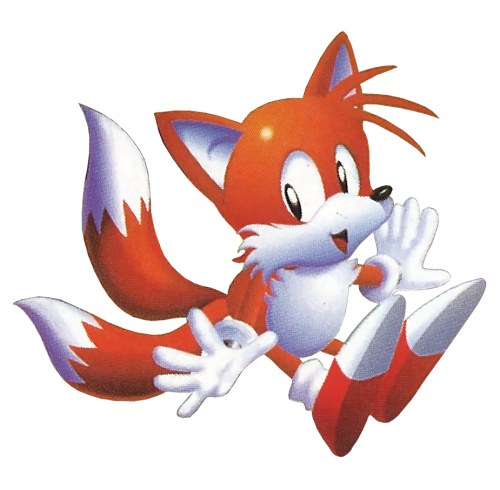 | Miles “Tails” Prower | My real name is Miles, but everyone calls me Tails. My goal is to be like Sonic! But I still have a lot of training to do… |
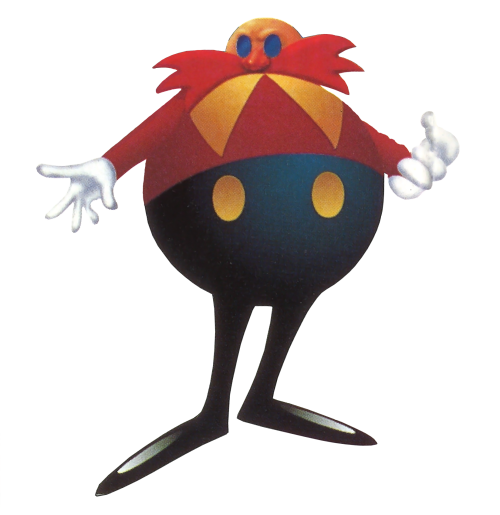 | Doctor Eggman | Eggman is never discouraged by his defeats… In spite of everything, he’s back for a third time! His favorite things are the Chaos Emeralds. His least favorite is Sonic. His hobby is, as always, world domination![4]Sonic & Tails (Sega Game Gear) Japanese instruction booklet, pg. 26. |
Gameplay
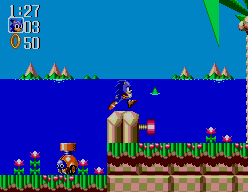
Sonic Chaos is a classic 2D side-scrolling platformer that maintains the gameplay style of its 8-bit predecessors in the Sonic the Hedgehog series. Players have the choice to control either Sonic the Hedgehog or Miles “Tails” Prower. Sonic begins with three lives and no Continues, while Tails provides five lives and three Continues, albeit at a slower pace compared to Sonic. The primary objective is to navigate through each Act of a Zone within a given time limit.
Both characters can execute fundamental moves like the Spin Jump and Super Spin Attack, along with the addition of the Super Spin Dash from Sonic the Hedgehog 2. Borrowing from Sonic the Hedgehog CD, Sonic also employs the Strike Dash for rapid acceleration. Tails boasts his unique ability, Airman Tails, allowing him to glide temporarily through the air.
Rings are scattered throughout every Zone, acting as a protective shield against damage. If hit, the player loses their collected Rings, with the chance to recover some before they vanish. Another hit without Rings results in the loss of a life and a restart of the Act. Losing air supply underwater, falling into pits, or running out of time also deducts lives. Running out of lives with zero Continues remaining results in a game over. Sonic can enter Special Stages by collecting 100 Rings, while Tails gains an extra life for the same feat. Rings contribute to end-of-Act scores for each character.
Sonic Chaos follows the tradition of other Sonic games by featuring Video Monitors containing power-ups like Super Rings (granting extra Rings), Speed Shoes (brief speed boost), Invincibles (temporary invulnerability), and Extra Lives. Sonic has an exclusive power-up, the Rocket Shoes, allowing him to fly for a short duration. In Tails’ Acts, Rocket Shoes are replaced with Super Rings.
Each Zone is relatively brief, with linear layouts and minimal alternate paths. Common features include loops, corkscrews, high-speed warp tubes, and Pogo Springs activated from metallic boxes, propelling the player to greater heights. In addition to the main goal, players can collect the Chaos Emeralds, with the first five acquired in Special Stages and the sixth earned automatically after defeating the final boss. Collecting all six unlocks the satisfying cinematic ending, though Tails ensures a good ending regardless of the player’s choice.
Scoring System
Main article: Point
Controls
| Button formation | Movement | ||
|---|---|---|---|
| Master System[8]Sonic Chaos (Sega Master System) Australian instruction booklet, pgs. 3-4 | Game Gear[9]Sonic Chaos (Sega Game Gear) United States instruction booklet, pgs. 6-7. | ||
| Walk/Run | |||
| Look up | |||
| Look down/Crouch | |||
| Jump | |||
| Super Spin Attack | |||
| Super Spin Dash/Super Dash Attack | |||
| Strike Dash | Airman Tails/Helicopter | ||
| Pause | START | Pause | |
Objects
Items
- Air Bubble
- Chaos Emerald
- Large Ring
- Ring
- Video monitor[10]Sonic Chaos (Sega Game Gear United States instruction booklet, pg. 8.
- Extra Life/1-UP[11]Sonic Chaos (Sega Master System) Australian instruction booklet, pg. 5
- Invincible
- Power Sneakers
- Rocket Shoes (first appearance)
- Super Rings
- Time Stop (first appearance)
Gimmicks and Obstacles
- Bonus Plate
- Booster
- Conveyor Belt
- Giant spear
- High-speed warp tube
- Pogo Spring/Hop Spring (first appearance)
- Spikes
- Spring
- Switch
Bonus Plate Rewards
Similar to earlier games, Sonic Chaos includes Bonus Plates that appear at the conclusion of the first and second Acts within each Zone. After crossing these plates, the player’s velocity, apparently linked to the time taken to complete an Act, is calculated in kilometers per hour (km/h). The maximum achievable speed is 999 km/h. Achieving a measurement with three identical numbers, like 555 km/h, rewards the player with an Extra Life. Furthermore, as the Bonus Plates rotate upon being crossed, they bestow awards corresponding to the displayed image. The possible rewards comprise:
| Image | Name | Reward[12]Sonic & Tails Sega Game Gear Japanese instruction booklet, pg. 16.[13]Sonic Chaos (Sega Master System) Australian instruction booklet, pg. 6 |
|---|---|---|
| Dr. Eggman (default) | Nothing | |
| Sonic | Extra Life (Sonic) Continue (Tails) | |
| Ring | 10 Rings & 100 points | |
| Tails | Extra Life (Tails) Continue (Sonic) | |
| Flicky | Nothing | |
| Backwards | Spin plate again |
Characters

Playable characters
- Miles “Tails” Prower
- Sonic the Hedgehog
Non-playable characters
- Dr. Eggman
- Flicky
Enemies
- Boing-o-Bot (first appearance)
- Bomblin
- Buzz Bomber
- Frogger (first appearance)
- Mecha Hiyoko
- Metal-o-Turtle (first appearance)
- Veg-o-Bot (first appearance)
Bosses
- Lady Bug Boss
- Bead Worm Boss
- Bouncy Boss Robot
- Tree Crawler Boss
- Sphere-o-Bot Boss
- Laser Walker
Zones
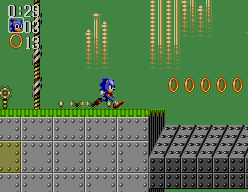
Sonic Chaos encompasses a total of six distinct Zones, with each Zone being divided into three separate Acts. Once the player successfully completes the initial two Acts of a Zone, they confront the Zone’s boss within a shorter third Act. Overcoming the boss enables the player to advance to the subsequent Zone. The sequence of Zones is as follows:
- Turquoise Hill Zone
- Gigalopolis Zone
- Sleeping Egg Zone
- Mecha Green Hill Zone
- Aqua Planet Zone
- Electric Egg Zone
Special Stages
Main article: Special Stage (Sonic Chaos)
Special Stages in Sonic Chaos offer additional levels where players can acquire five out of the six Chaos Emeralds. Gaining access to these Special Stages requires the player to amass 100 Rings while controlling Sonic during an Act.
Distinguished by their individual level designs, the Special Stages in Sonic Chaos deviate from those in other Sonic the Hedgehog games. Each Special Stage presents its own distinct challenge, necessitating tasks such as aerial traversal, navigating through warp tube mazes at high speeds, ascending platforms, or completing time-sensitive speed runs. Typically, players must navigate through the obstacle courses of these Special Stages within a time limit of sixty seconds in order to secure a Chaos Emerald. Conclusion of a Special Stage occurs when time runs out, the player falls off-screen, or the Emerald is reached (earning an additional Continue). Subsequently, the player proceeds to the subsequent Act in the Zone. If the player has already obtained all Chaos Emeralds, collecting 100 Rings will no longer transport Sonic to the Special Stage but will instead reward an Extra Life.
Reception
Upon its release, Sonic Chaos garnered generally positive reviews from critics. GamePro lauded the game’s graphics and gameplay, highlighting its appeal to fans of the Sonic series, even though it was considered less challenging compared to other Sonic adventures. Sega Magazine also commended the Master System version for its polished graphics and engaging gameplay, making it an enjoyable experience that kept players coming back for more. Electronic Gaming Monthly awarded the game an 8.25 out of 10, praising its retention of the elements that made the 16-bit Sonic games enjoyable and lauding the addition of playing as Tails.
However, as time went on, the game received more mixed reviews. IGN’s Lucas M. Thomas, in a Virtual Console re-release review, gave it a score of 6 out of 10, noting that while Sonic Chaos had some unique aspects, it closely resembled previous Sonic titles. Eurogamer’s Dan Whitehead also gave it a 7 out of 10 for its Virtual Console re-release, pointing out that its relative obscurity could make it appealing to Sonic fans looking for a fresh experience. On the other hand, Nintendo Life’s Darren Calvert criticized the game for lacking inspiration and challenge, suggesting that only dedicated Sonic fans might find value in this lesser-known installment.
Sonic Chaos was recognized as the “Best Sega Game Gear Game of 1993” by Electronic Gaming Monthly.
Re-Releases
Following its initial release, Sonic Chaos received re-releases and appearances in various compilations. In the United States, distributing company Majesco brought the game back for the Sega Game Gear, leading to a re-rating as “E for Everyone” by the newly established Entertainment Software Rating Board. Notably, Sonic Chaos was one of the earliest Sonic titles to undergo this re-rating.
Later, the Game Gear version of Sonic Chaos became unlockable content in Sonic Adventure DX: Director’s Cut. To access it, players needed to amass 60 emblems or complete 60 missions across all playable characters. The game was also featured in Sonic Mega Collection Plus in 2004.
Sonic Chaos found a place in the Sonic the Hedgehog plug-and-play console by Techno Source, released in 2005. It was also included in Coleco’s “PlayPal Plug & Play” console, dedicated to Game Gear titles, in 2006. The Sega Master System version of Sonic Chaos re-emerged in 2009 through a port for the Wii’s Virtual Console. Then, in 2020, the Game Gear version became part of the blue Game Gear Micro.
The Game Gear version of Sonic Chaos is also playable in Sonic Origins Plus, released on June 23, 2023.
Platform Differences
The Sega Master System and Game Gear versions exhibit several notable differences between their respective releases, encompassing:
- Resolution and Viewing Area: The resolution was reduced, sometimes affecting the viewing area. Rings flying upward upon taking damage might disappear at the screen’s top due to the altered dimensions.
- Color Palette: The Game Gear version made greater use of the console’s extended color range. Visual changes include the transformation of the distinctive peach and brown checkered soil in Turquoise Hill Zone to the familiar orange and yellow pattern, and adjustments to the green skyline with pink streaks in Mecha Green Hill Zone to a pink hue with green streaks.
- Title and Character Select Screens: Changes were introduced to the title screen, character select screens, and Zone title card fonts.
- Music Arrangements: Some of the music underwent mild rearrangements. Notable changes can be observed when comparing the themes of Turquoise Hill Zone, Sleeping Egg Zone, and Aqua Planet Zone.
- Gigalopolis Zone Theme: Gigalopolis Zone’s theme was entirely reworked for the Game Gear version.
- Audio Adjustments: The track playing upon obtaining a Chaos Emerald was removed, but music was added to the previously silent Power Sneakers power-up. Additionally, an original piece was introduced for the intro instead of using the Electric Egg Zone theme.
- Boss Fights: Bosses underwent redesign to accommodate the smaller viewing area, resulting in slightly stretched proportions.
- Layout Changes: Alterations were made to Act 3 layouts in most, if not all, Zones.
- Boss Behavior: The Bead Worm Boss no longer shoots a spiked ball after defeat, and the Tree Crawler Boss is encountered over flat ground instead of a pit of spikes.
- Boss Hit Points: The number of hits required to defeat the first four Master Robots was adjusted between the Master System and Game Gear versions. Notably, the fifth boss took fifteen hits to defeat in the Game Gear version, up from the original eleven.
- Game Ending: Following the final boss fight, a different ending sequence plays in the Game Gear version, replacing the original simple fade to white.
- Bad Ending Animation: Sonic’s actions during the bad ending were altered. In the Master System version, Sonic rolled, whereas in the Game Gear version, he initially walks and then stumbles as he begins running after Robotnik.
- Credits: Tails’ name in the credits of the Master System version was mistakenly written as “Miles Power,” which was corrected to “Miles Prower” in the Game Gear version.
- Japanese Version Changes: The Japanese Game Gear release featured further modifications, including alterations to the font, title screen, and the substitution of “Eggman” for “Robotnik” in the cast roll. Despite these changes, Gigalopolis Zone retained its name, while other regions changed it to Gigapolis Zone.
Cheat Codes
Level Select: To access the Level Select feature, follow these input instructions during the “Press Start” text on the title screen:
For Game Gear:
- Up, Up, Down, Down, Right, Left, Right, Left, START.
For Master System:
 Up, Up, Down, Down, Right, Left, Right, Left,
Up, Up, Down, Down, Right, Left, Right, Left,  ,
,  .
.
Sound Test: To activate the Sound Test, use the following input commands during the “Press Start” text on the title screen:
For Game Gear:
 Down, Down, Up, Up, Left, Right, Left, Right, START.
Down, Down, Up, Up, Left, Right, Left, Right, START.
For Master System:
 Down, Down, Up, Up, Left, Right, Left, Right,
Down, Down, Up, Up, Left, Right, Left, Right,  ,
,  .
.
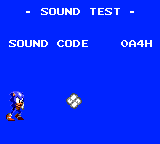
Hadoken Easter Egg: In the Sound Test of either version, input this sequence:
 down, down-right, right,
down, down-right, right,  /
/ .
.
Sonic will perform a fireball attack resembling the Hadoken move from Street Fighter.
Bonus Plate Tricks: You can manipulate Bonus Plate rewards based on your Ring count in each Zone. Here are the strategies for different Zones:
For Turquoise Hill Zone, Sleeping Egg Zone, and Aqua Planet Zone:
- Super Ring: Numbers ending in 9 (e.g., 9, 19, 29, etc.).
- Continue: 15, 30, 40, or 60 Rings.
- Backwards Plate: 16, 28, 32, 44, or 58 Rings.
- 1-UP: 55, 65, 77, 88, 95, 97, or 99 Rings.
For Gigalopolis Zone, Mecha Green Hill Zone, and Electric Egg Zone:
- Super Ring: Multiples of 10 (e.g., 10, 20, 30, etc.).
- Continue: 0, 24, 48, or 72 Rings.
- Backwards Plate: 18, 36, 45, 81, or 89 Rings.
- 1-UP: 11, 33, 77, 87, 94, 96, or 98 Rings.
Trivia
- Sonic Chaos introduced a unique feature to the Sonic series by displaying the player’s speed in kilometers per hour (km/h) at the end of each Act, showcasing the sense of speed in the game. This speedometer mechanic was only found in two other games: Sonic Labyrinth and Sonic Unleashed.
- The background music for Mecha Green Hill Zone is a remixed version of Green Hills Zone’s music from the 8-bit Sonic the Hedgehog 2. Interestingly, this remixed track was also used in the main theme of the Japanese soundtrack for Sonic the Hedgehog CD, known as “Sonic – You Can Do Anything.”
- Similarly, the final boss theme in Sonic Chaos is an arranged version of the boss theme from the previous Sega Game Gear game, which was further remixed into the music for Metallic Madness in Sonic the Hedgehog CD.
- Within the game’s Sound Test feature, there’s a track labeled “BGM#09BH” that never plays during regular gameplay. Curiously, this track was later used in Sonic the Hedgehog Triple Trouble as the background theme for Sunset Park Act 3.
- The title and life lost themes from the 8-bit Sonic the Hedgehog 2 are repurposed in Sonic Chaos, albeit in a higher pitch.
- Notably, Sonic Chaos introduced the ability for Miles “Tails” Prower to fly using his distinctive twin tails, a gameplay element that was a first for the series.
Archive Links





References
- ↑ Sonic Chaos (Sega Game Gear United States instruction booklet, pg. 4.
- ↑ Sonic & Tails (Sega Game Gear) Japanese instruction booklet, pgs. 4-5.
- ↑ Sonic & Tails (Sega Game Gear) Japanese instruction booklet, pg. 11.
- ↑ Sonic & Tails (Sega Game Gear) Japanese instruction booklet, pg. 26.
- ↑ Sonic Chaos (Sega Game Gear) United States instruction booklet, pg. 10.
- ↑ Sonic Chaos (Sega Game Gear) United States instruction booklet, pg. 9.
- ↑ Sonic Chaos (Sega Game Gear) United States instruction booklet, pg. 12.
- ↑ Sonic Chaos (Sega Master System) Australian instruction booklet, pgs. 3-4
- ↑ Sonic Chaos (Sega Game Gear) United States instruction booklet, pgs. 6-7.
- ↑ Sonic Chaos (Sega Game Gear United States instruction booklet, pg. 8.
- ↑ Sonic Chaos (Sega Master System) Australian instruction booklet, pg. 5
- ↑ Sonic & Tails Sega Game Gear Japanese instruction booklet, pg. 16.
- ↑ Sonic Chaos (Sega Master System) Australian instruction booklet, pg. 6
External Links
- Sonic & Tails at Sega’s Wii re-release mini-site (Japanese)
- Sonic Chaos at Nintendo (English)
